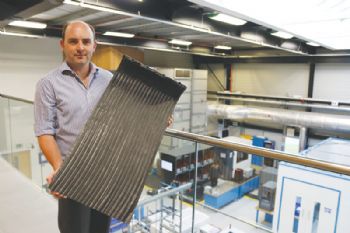
A 3-D woven composite component, capable of withstanding extreme temperatures inside a fusion nuclear reactor, is being developed at the University of Sheffield Advanced Manufacturing Research Centre (AMRC) in collaboration with the UK Atomic Energy Authority (UKAEA) as part of an effort to accelerate the delivery of ‘limitless zero-carbon fusion energy’.
The work was commissioned by the Joining and Advanced Manufacturing (JAM) programme, which forms one of three fusion technology facilities at UKAEA.
The AMRC, part of the High Value Manufacturing (HVM) Catapult, worked with Lyndsey Mooring, technical lead for non-metallics, to explore how composite materials could produce components that are stiffer, lighter and easier to manufacture than those currently in use, while retaining the necessary capabilities.
The UKAEA is involved in developing the next generation of magnetic confinement reactor (called a tokamak) at its site in Culham, Oxfordshire.
Research is focused on preparing for the international tokamak experiment at the International Thermonuclear Experimental Reactor (ITER) in Saint-Paul-lès-Durance in southern France — and for the following machine, which is expected to demonstrate the generation of power from fusion.
In September, the UKAEA announced that it would be building a new £22 million fusion energy research facility at the Advanced Manufacturing Park in Rotherham.
This will include a test facility that reproduces the thermohydraulic and electromagnetic conditions in a fusion reactor.
The centre will work with industrial partners to commercialise nuclear fusion as a major source of low-carbon electricity.
Fusion occurs when two types of hydrogen atoms — tritium and deuterium — collide at high speed to create helium and release a high-energy neutron.
Once released, the neutron interacts with a much cooler breeder blanket to absorb the energy.
The breeder blanket must capture the energy of the neutrons to generate power, prevent the neutrons escaping, and ‘breed’ more tritium through reactions with lithium contained in the blanket.
Each blanket typically measures about 1 x 1.5m and currently weighs up to 4.6 tonnes.
Steffan Lea, research fellow at the AMRC Composite Centre, said: “At the moment, the designs being tested in ITER use steel for the breeder blanket’s structure, which has a network of double-walled tubes (with an 8mm internal diameter and 1.25mm wall thickness) to collect the heat.
“Each one is welded into place, and every connection has to be inspected. That is what we were asked to replace.
“Currently, the steel modules are limited to about 500˚C, so UKAEA asked us if there was anything we could do to get it up to 600˚C.
“We set out to see what materials we could use to enable higher-temperature operation.”

Engineers at the AMRC proposed to make use of high-performance ceramic composite materials and to form a ‘unitised 3-D woven structure’ with additive-manufacture components.
The cooling tubes in the breeder blanket would be integrated into the material and 3-D printed parts used to define features such as connectors and manifolds.
Joe Palmer, AMRC project manager, said: “We wanted to maximise the available surface area for heat transfer while being as lightweight as possible, but ensure that it occupied a similar volume to the existing breeder blanket designs.
“To achieve a lightweight temperature-resistant structure, a silicon carbide composite material was chosen for the breeder blanket, with the internal flow channels being created by forming the composite around a disposable core.”
Multiple weave zones
With a computer-aided design (CAD) model produced, Chris McHugh, AMRC Composite Centre dry fibre development manager, then created a weave design for the composite.
He said: “The design I created had multiple weave zones and multiple layer weaves.
“The structure needed holes robust enough to include tubes and needed to maintain the pre-form shape without distortion.
“What we were able to produce on the loom was a 3-D woven structure with pockets for the 3-D printed tubes, which could be formed into a ridged component.”
Mr Lea added: “What we were able to do was replace a metallic box, made of different steel components, with a malleable textile fabric that had cooling pipes running the length of it.
“Using advanced manufacturing technologies available at the AMRC, we have integrated the function of cooling, simplified the design and removed the welding operation, so reducing the burden of qualification.
“When maintenance happens in the nuclear fusion reactors, these components are lifted remotely by robot, so using these materials, which are far lighter and can also be stiffer, would bring great benefits in terms of how the reactors are built.”
Elizabeth Surrey, UKAEA head of technology in Culham, said: “Designing a fusion reactor is possibly the most challenging engineering project ever undertaken.
“We need to explore disruptive manufacturing technologies to satisfy the operational requirements of high-temperature, low-weight and high-strength structures using materials that offer low nuclear activation.
“For fusion to become a commercial source of clean energy, the structures need to be modular and easily manufactured, with an operational lifetime of decades.
“Standard manufacturing routes struggle to meet all these requirements.
“That is why we turned to the expertise of the AMRC to investigate the possible application of silicon carbide to this problem.
“Recent advances in silicon carbide manufacturing technology may offer the possibility of using this material in a fusion reactor; it has so many advantages that it must be considered.”
Mr Lea said: “We have successfully demonstrated that the initial concept works.
“The next step is to continue the silicon carbide composite development and build a demonstrator that can be tested inside a reactor test facility in order to understand how it performs and reacts to the environment.
“If nuclear fusion is going to be realised, you need a simple design for breeder blankets that are manufacturable and easily replicated. That is what we have tried to create.”